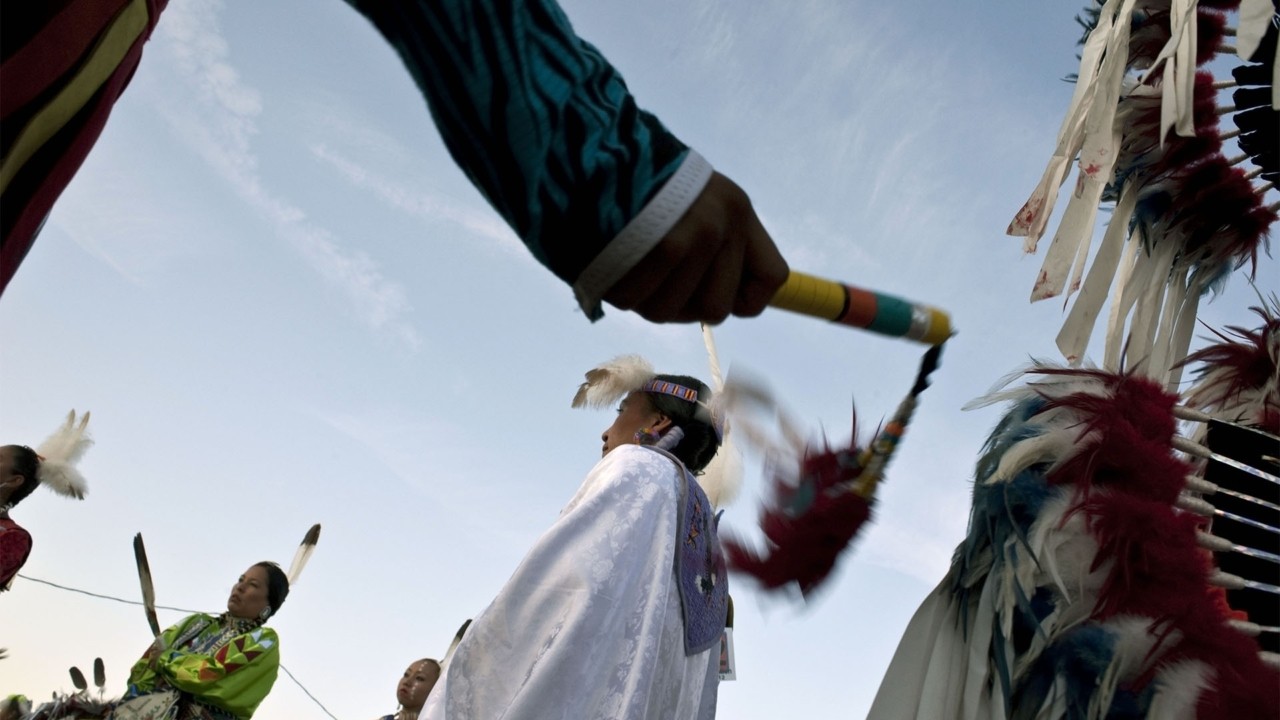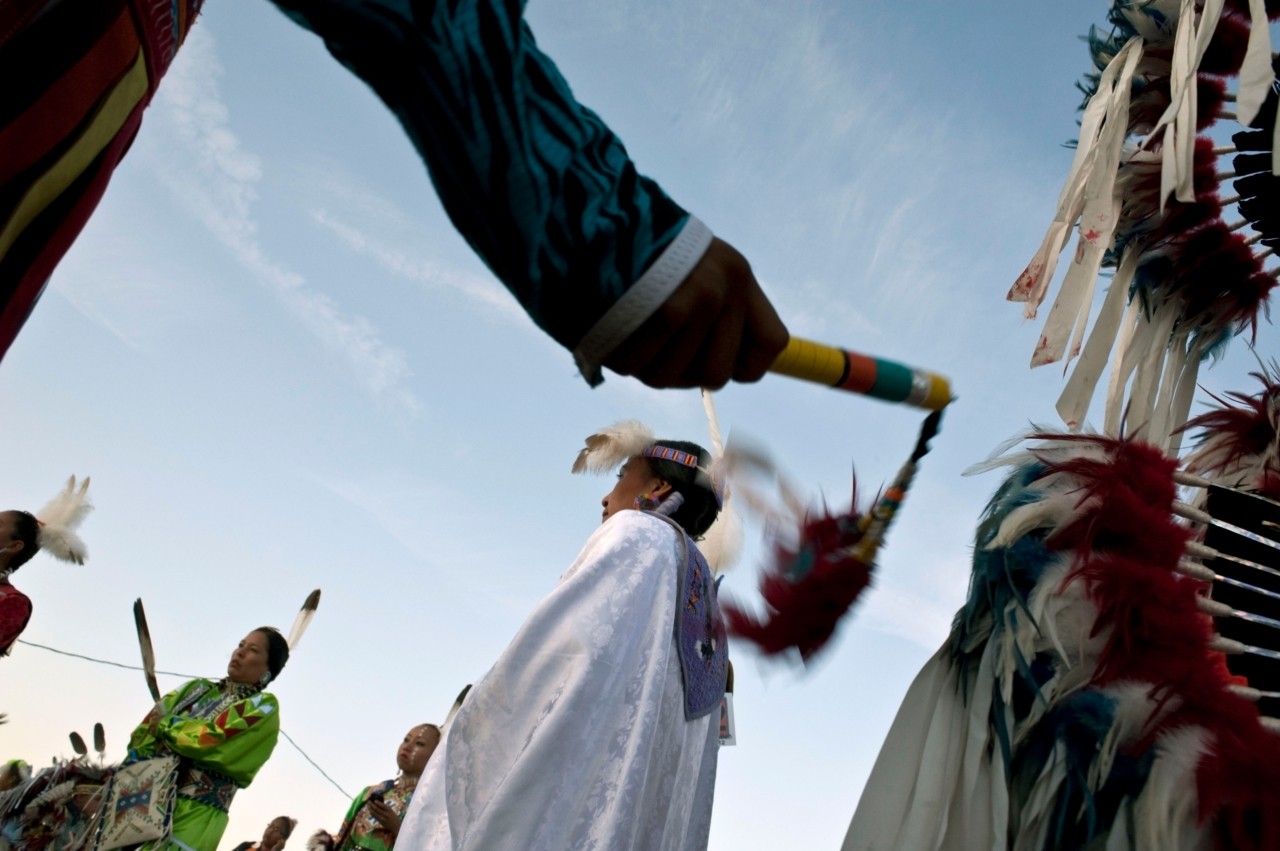

Photograph by Larry Towell / Magnum Photos
Words by Ruth H. Burns
You’ve likely heard the term “powwow” thrown around by non-Natives in office settings or in casual conversation, but do you know what the word really means? Powwows are not informal gab sessions held on bar stools or in boardrooms. Powwow began as an Algonquin word—“pau wau,” translated in English as “he dreams”—and they are celebrations of Indigenous culture with Tribal dances, music, art, and foods that are unique to Native Nations.
To misuse the expression powwow maligns its true meaning and significance. It’s a shame, too, because powwows are special events open to the public where Native folks share our diverse cultures with sincere souls who arrive with an open heart.
Hundreds of powwows are held all over the United States and Canada every year. They vary in size, from several dozen individuals to thousands of people in attendance. Some powwows are annual gatherings held by Tribes or organizations where friends and family reconnect. Others may be held to honor veterans, graduates, holidays, or mark other extraordinary occasions. They may last just one day or several, and while powwows occur year round, they are most often held in the summer when the weather is nice and when more people are able to travel.
The origins of powwows stem from traditional dances held by individual Tribes in precolonial times. Dances commemorated happenings or were performed during rituals. Once Tribes were forcibly relocated onto Reservations and their ceremonies and spiritual beliefs outlawed, powwows open to outsiders became a means of keeping cultures alive, because they were permitted by federal agents who kept watch over Native peoples within their lands.
The music at powwows today primarily occurs around the drum, which represents the heartbeat of all things, from human beings to Mother Earth. Some songs are ancient, going back hundreds, or even thousands of years. Others are contemporary, and new songs continue to be written every day. Drum groups who travel the powwow circuit, like popular powwow dancers, can reach a celebrity status of sorts. You will find their music on albums, YouTube, and all manner of music streaming platforms. Some drum groups, such as those featured on the 1999-2001 Gathering of Nations Pow-Wow Compilation album, have won Grammy awards.
While not mandatory, many powwows provide prizes, including large sums of money, to the winners of various contest categories typically divided by age group and the type of dance one performs. Other powwows, considered more traditional, provide smaller sums to everyone who dances, especially tiny tots. The tiny tot category features children under the age of five who show out in their best powwow outfit or regalia. It is not a costume! The prize money helps participating dancers and singers defray the cost of traveling many miles to attend powwow gatherings.
The music at powwows today primarily occurs around the drum, which represents the heartbeat of all things, from human beings to Mother Earth.
Songs and regalia have evolved over time, because our cultures live, like the People. We are vibrant and ever changing.
Each powwow starts with Grand Entry. During Grand Entry, dancers line up by category and age group in their one-of-a-kind regalia composed of intricate bead, quill, and leather work as well as ribbons, fringe, bells, and eagle feathers. Some dancers wear regalia that came to them in a dream.
An Arena Director acts as an announcer and Master of Ceremonies (M.C.). He introduces powwow royalty, who represent various Tribes or organizations, each category as they enter the arena, and drum groups who play for the dancers around the perimeter. Veterans holding flags frequently enter the arena at the commencement of Grand Entry because Tribes historically hold akicita (warriors) charged with protecting the People and the land in exceptionally high regard.
Throughout the day and into the night, contests are held where each category, by age and dance type, are showcased.
While there are variations, most powwows hold contests for traditional dance styles, fancy dancing, grass dancing, and jingle dress. Each dance style has a unique origin story. For example, the jingle dress category is so-named for the dress the dancers wear. The dance originated as a means of healing the sick. The dresses are medicine. Another example is grass dancing, which began as a practice that was used to stomp down tall prairie grass as our ancestors traveled across the plains. One version of grass dancing is derived from a dance warriors would do after they tied one of their legs to a stake. This was done during raids. By staying behind, staked to the ground, these warriors were buying time for the rest of their village to escape—risking their lives. Other types of dances, like smoke dances or chicken dances, may only be found in certain regions.
Elders compete against one another in a golden age category. There are also distinct competitions for adults, youth, and children, separated by which sex they identify as. Judges with expertise in each dance style select winners. Besides contests, there are also intertribals, where members of the public, regardless of whether they are wearing regalia, are invited to come into the arena and take part in the dancing. Non-Natives are welcome to participate. Powwows regularly have special honorings and memorials interspersed throughout the powwow schedule as well. There are also feasts held that feed all present, although you would likely be tempted to peruse vendors offering all manner of Native delicacies, like frybread or Indian Tacos.
Powwows are a celebration of life, a waking dream. We sing, we dance, we unite as one because we are still here.
If you have the chance to attend a powwow, do it. It is an opportunity to learn about Indigenous cultures, experience Native life, meet new, interesting people, and engage with our traditions. That said, here are a few tips on powwow etiquette:
Dancers are adorned in beautiful regalia that is a feast for the eyes. They welcome your contemplation, but be courteous. While anyone may take pictures during Grand Entry, if you wish to photograph individual dancers outside of the arena, ask them for permission first. Also, do not touch them uninvited. The dancers may be wearing items of antiquity that have been passed down to them by their ancestors, so they could be fragile. Other pieces of regalia may be of particular religious significance. Do not touch a Native person’s hair without their consent, either. While each Tribe is unique, it is a common belief across Native Nations that our hair possesses powerful spiritual import.
Occasionally, there may be religious ceremonies that are conducted during a powwow. If the arena director asks that you not record these events, please honor that request. Arena directors will also ask that you stand, if you are able, during specific songs. Their instructions should be followed.
Dancers may wear eagle feathers. While dancers take care to secure their feathers, sometimes they fall off. If you spot an eagle feather, notify powwow staff, so the eagle feather may be properly returned. Because eagle feathers are sacred, there is a ritual that must be performed if it lands on the ground. Moreover, according to U.S. law, it is illegal for non-Natives to possess eagle feathers.
I attended my Tribe’s annual wacipi (powwow) last month on the weekend of July 4. Our powwow is the oldest in South Dakota, and the second oldest in the entire United States. Dancers of all ages from all over North America showed out in their finest regalia. Even spotty thunder showers couldn’t deter the public from partaking in the outdoor festivities. It was a pleasure to gather with old friends and meet new relatives. Later that same month I also attended another powwow, on my husband’s ancestral homelands.
Powwows are, above all, above all a celebration of life, a waking dream. We sing, we dance, we unite as one because we are still here.
Powwows Are a Celebration of Life. Here’s How.